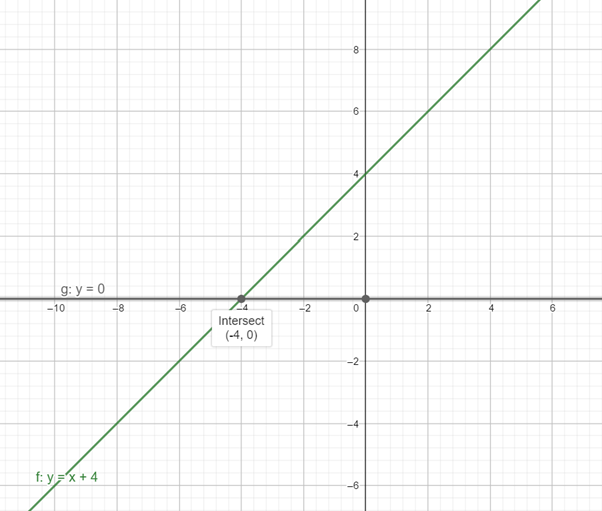
Tosolve: the system of equations by graphing.
Answer to Problem 14IP
The solution of the system of equation is
Explanation of Solution
Given information:
The system of equation is
Calculation: to find solution of the system of equations, first graph the both equations in the same coordinates plane,
To graph the equations, use the point plotting method,
| | |
| | |
| | |
| | |
By using above table, and joint the points smoothly,
The graph of the lines can be obtained as:

From the above graph it can be observed that the both lines intersect each other at the point
Thus, the solution is
Chapter 9 Solutions
Glencoe Math Accelerated, Student Edition
Additional Math Textbook Solutions
Thinking Mathematically (6th Edition)
Elementary Statistics (13th Edition)
Introductory Statistics
University Calculus: Early Transcendentals (4th Edition)
College Algebra with Modeling & Visualization (5th Edition)
Pre-Algebra Student Edition
- 1. The average value of f(x) = ✓ on [1,4] and instantaneous rate of change at x = 16 2. f(x) = x³-3x² + 4 Find all relative extrema, inflection point, and the intervals of concavityarrow_forward2. f(x) = x³-3x² +4 Find all relative extrema, inflection point, and the intervals of concavity 5 3. f(x) = 3x3 - 15x3 Find the intervals of increasing, decreasingarrow_forward5 2 3. f(x) = 3x3 - 15x3 Find the intervals of increasing, decreasing 4. If xy+cos y, Findarrow_forward
- #IN A [2 pts.] C 0 II. Consider the circle C r = 4 cos 0 and the line Cr=sec as in the figure on the right. Let A and B be the points of intersection of the two curves as shown. 1. Find the polar coordinates of A and B. 2. Find a Cartesian equation of the tangent line to C at the point where [4 pts.] 3. Set up (and do not evaluate) a definite integral or a sum of definite integrals that yields the follow- ing: a. the length of the portion of C traced counterclockwise from A to B. b. the area of the shaded region. [2 pts.] [3 pts.] B Carrow_forwardI. Perform the following integrations. 1. L' (2x + 1)e³r da cot³ (ln x) csc³ (ln x) 2. dx х 3. 4. x² √1-92 dx 3x3 +14x+7 x² (x²+7) dxarrow_forwardIV. Consider the equation : y + z = 2. 1. Sketch a portion of the graph of π in the first octant in R3. Indicate proper rulings. [2 pts.] 2. Find an equation of the surface generated by revolving the trace of π on the the yz-plane about the y-axis. Sketch the surface of revolution. [3 pts.]arrow_forward
- IV. Consider the function f(x) = esin 2x 1. Find the second-degree Maclaurin polynomial of f(x). 2. Approximate esin 0.02 using the result in IV.1. Express your answer in decimal form.arrow_forwardIII. Find the center-radius form of the equation of the sphere having the line segment with endpoints P(1,-2, 1) and Q(5, 0, 1) as a diameter. [2.5 pts.]arrow_forwardII. Determine if the improper integral is convergent or divergent. 0 2x2 L dx -2 x3+8arrow_forward
- 2+5n2 1. Determine whether the sequence (b) converges or diverges. 2. Determine whether the following series converge or diverge. State the test you us 3n² - n I. Let bn = for n N with n ≥ 1. نے n=1 8 b. (bn)" n=1arrow_forwardII. Determine whether the following series converge or diverge. State the test you used. (4/2/3 po 1 1. n(Inn)2 n=3 2. 8 IM n=1 5" + sin² n 3n 00 1.3 " 3. (2n − 1) (n + 2)! - n=1arrow_forward7. Consider the following parametric curve: x = sint, y = 2 cost, for 0 ≤t≤ a) Eliminate the parameter to find a rectangular equation for the curve. b) Use the parametric equations to find the slope of the tangent line when t = c) Use the parametric equations to set up an integral to represent the arc length of the curve. You do not need to evaluate the integral.arrow_forward
 Calculus: Early TranscendentalsCalculusISBN:9781285741550Author:James StewartPublisher:Cengage Learning
Calculus: Early TranscendentalsCalculusISBN:9781285741550Author:James StewartPublisher:Cengage Learning Thomas' Calculus (14th Edition)CalculusISBN:9780134438986Author:Joel R. Hass, Christopher E. Heil, Maurice D. WeirPublisher:PEARSON
Thomas' Calculus (14th Edition)CalculusISBN:9780134438986Author:Joel R. Hass, Christopher E. Heil, Maurice D. WeirPublisher:PEARSON Calculus: Early Transcendentals (3rd Edition)CalculusISBN:9780134763644Author:William L. Briggs, Lyle Cochran, Bernard Gillett, Eric SchulzPublisher:PEARSON
Calculus: Early Transcendentals (3rd Edition)CalculusISBN:9780134763644Author:William L. Briggs, Lyle Cochran, Bernard Gillett, Eric SchulzPublisher:PEARSON Calculus: Early TranscendentalsCalculusISBN:9781319050740Author:Jon Rogawski, Colin Adams, Robert FranzosaPublisher:W. H. Freeman
Calculus: Early TranscendentalsCalculusISBN:9781319050740Author:Jon Rogawski, Colin Adams, Robert FranzosaPublisher:W. H. Freeman
 Calculus: Early Transcendental FunctionsCalculusISBN:9781337552516Author:Ron Larson, Bruce H. EdwardsPublisher:Cengage Learning
Calculus: Early Transcendental FunctionsCalculusISBN:9781337552516Author:Ron Larson, Bruce H. EdwardsPublisher:Cengage Learning





